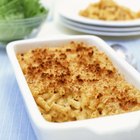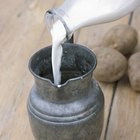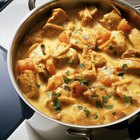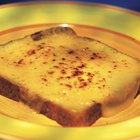
Milk is a highly nourishing food, filled with proteins, calcium, minerals and vitamins. Using a milk-based sauce for casseroles and baked pasta dishes increases their nutritional value significantly, while adding only minimal quantities of fat. Unfortunately, milk will sometimes curdle while your macaroni dish is in the oven. Curdling is a simple problem to prevent if you understand why it happens.
The Anatomy of Milk
Milk is familiar enough that cooks tend to take it for granted, but it's really a complex ingredient. Milk is a mixture of water, fat, minerals and several kinds of proteins held together in a stable suspension. Its fat content ranges from almost none in the case of non-fat milk to an average of more than 3 percent for whole milk. That low level of fat is the reason milk curdles easily when it's cooked while heavy cream does not.
Milk and Heat
When you heat milk, its proteins react the same way as the proteins in meats or eggs do. They begin to shrink and tighten, often forming a skin at the top or bottom of the pot if they're heated on your stovetop. If the heat is too intense, the protein molecules bond together and shrink into tight, grainy lumps of curdled protein. This doesn't happen in heavy cream, because there's enough fat in the cream to prevent the protein molecules from bonding tightly to each other.
Stabilizing with Starches
When starches are heated in a liquid, their tight granules absorb moisture and begin to expand and unwind. As the temperature increases from approximately 135 to 180 degrees Fahrenheit, the chains of starch molecules gradually form a broad, three-dimensional mesh that immobilizes the liquid and forms a soft gel. When you use cornstarch or flour to thicken a sauce, this is the process that is occurring while you stir. If you use one of these starches to thicken your sauce, whether directly or in a flour-based roux, the mesh of starch will prevent the milk's proteins from bonding together to form curds.
The Technique
Some macaroni recipes simply call for the ingredients to be combined and added to the pasta, but this isn't a foolproof technique. The milk in your sauce may begin to curdle before the starches have finished thickening the sauce. It's better to prepare the sauce ahead of time on your stovetop, stirring it constantly until it's well thickened. At that point, the milk will be fully stabilized, and can be baked without the risk of curdling.
Related Articles

Why Does a Sauce Curdle?

What Does Rennet Do in Ice Cream?

How to Keep Coconut Milk From Curdling ...

Why Do Cream Soups Curdle and Turn Sour?

How to Keep Scalloped Potatoes From ...

Can You Use Bread Flour Instead of ...

How to Thicken Sauce With Powdered ...
How to Scald Milk for Cooking
What Do Bakeries Use in Their Whipped ...

Can You Bake Greek Yogurt?

Why Does Milk Curdle When it Is Mixed ...

Milk Protein for Skin Care

Cooking Yogurt Without Curdling It

What Can I Use to Thicken a Cream Sauce?

What Kind of Cheese Is a Low Melting ...

Isolation of Casein & Lactose From Milk

Can You Use Milk Instead of Cream for ...

How to Thicken Cream Filling

Why Does Milk Turn Yellow When It ...

How to Froth Milk With Hand Blenders
References
- On Food and Cooking: The Science and Lore of the Kitchen; Harold McGee
Writer Bio
Fred Decker is a trained chef and prolific freelance writer. In previous careers, he sold insurance and mutual funds, and was a longtime retailer. He was educated at Memorial University of Newfoundland and the Northern Alberta Institute of Technology. His articles have appeared on numerous home and garden sites including GoneOutdoors, TheNest and eHow.
Photo Credits
Jupiterimages/liquidlibrary/Getty Images